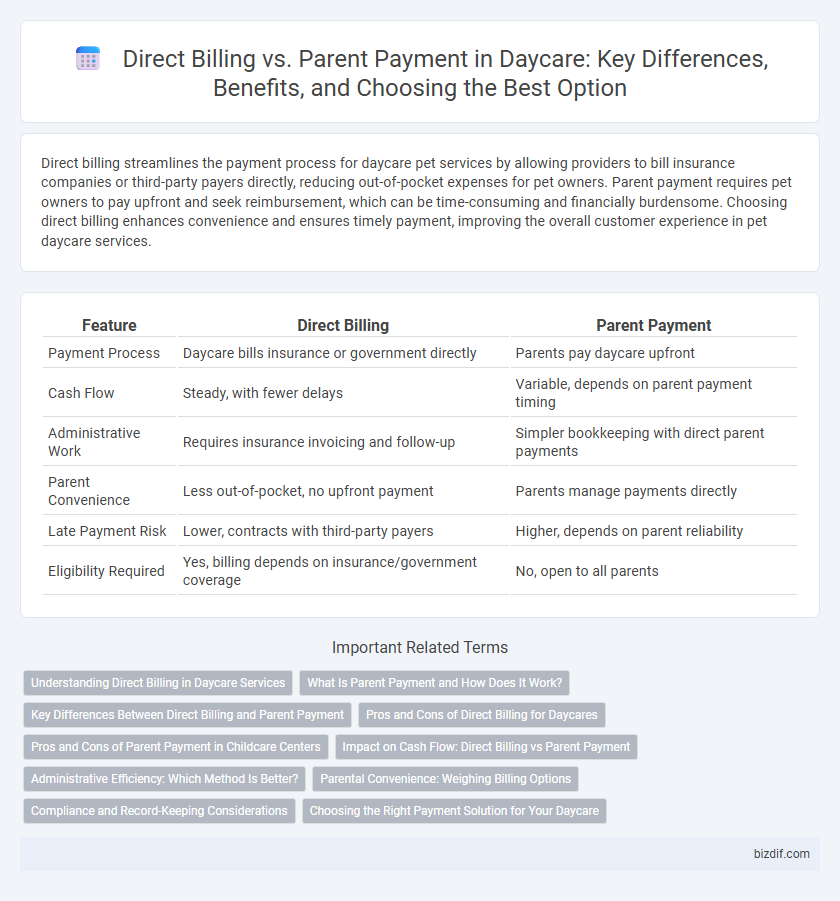Direct billing streamlines the payment process for daycare pet services by allowing providers to bill insurance companies or third-party payers directly, reducing out-of-pocket expenses for pet owners. Parent payment requires pet owners to pay upfront and seek reimbursement, which can be time-consuming and financially burdensome. Choosing direct billing enhances convenience and ensures timely payment, improving the overall customer experience in pet daycare services.
Table of Comparison
| Feature | Direct Billing | Parent Payment |
|---|---|---|
| Payment Process | Daycare bills insurance or government directly | Parents pay daycare upfront |
| Cash Flow | Steady, with fewer delays | Variable, depends on parent payment timing |
| Administrative Work | Requires insurance invoicing and follow-up | Simpler bookkeeping with direct parent payments |
| Parent Convenience | Less out-of-pocket, no upfront payment | Parents manage payments directly |
| Late Payment Risk | Lower, contracts with third-party payers | Higher, depends on parent reliability |
| Eligibility Required | Yes, billing depends on insurance/government coverage | No, open to all parents |
Understanding Direct Billing in Daycare Services
Direct billing in daycare services allows providers to invoice the government or insurance companies directly, eliminating the need for parents to pay upfront fees. This system streamlines payment processes, reduces administrative burdens for families, and ensures timely reimbursement for daycare centers. Understanding direct billing helps parents navigate financial options and access government subsidies or childcare benefits more efficiently.
What Is Parent Payment and How Does It Work?
Parent payment in daycare refers to the fees paid directly by parents for childcare services, covering tuition, meals, and extracurricular activities. This payment method requires parents to manage costs upfront or through scheduled installments, often via cash, check, or electronic transfers. Unlike direct billing, parent payment places financial responsibility on families, who then seek reimbursement or tax benefits if applicable.
Key Differences Between Direct Billing and Parent Payment
Direct billing in daycare involves the provider charging insurance or a third party directly, ensuring immediate payment without parental involvement, whereas parent payment requires families to pay out-of-pocket upfront and seek reimbursement independently. Direct billing reduces administrative burdens on parents and minimizes delayed payments, while parent payment offers more control and flexibility over expenses for some families. Understanding these key differences helps daycare providers and parents choose the most efficient and financially manageable payment method.
Pros and Cons of Direct Billing for Daycares
Direct billing in daycares streamlines payment by allowing fees to be charged directly to parents' insurance or subsidy providers, reducing administrative workload and ensuring timely transactions. However, this system may introduce delays due to insurance claim processing times and can complicate financial reconciliation for the daycare if payments are partial or denied. Daycares benefit from improved cash flow predictability but must manage potential discrepancies and maintain clear communication with parents regarding billing statuses.
Pros and Cons of Parent Payment in Childcare Centers
Parent payment in childcare centers offers greater flexibility and control over expense management, allowing families to choose preferred payment methods and schedules. However, this approach may increase administrative workload for parents, requiring timely payments to avoid service interruptions and added fees. Direct billing often reduces financial stress by automating payments but limits the parent's ability to adjust payment timing.
Impact on Cash Flow: Direct Billing vs Parent Payment
Direct billing improves daycare centers' cash flow by ensuring timely payments from funding agencies or employers, reducing the risk of delayed or missed payments from parents. Parent payment systems can create cash flow challenges due to late or partial payments, requiring additional administrative efforts to manage collections. Efficient cash flow management through direct billing supports daycare operations by providing steady revenue streams and minimizing financial uncertainty.
Administrative Efficiency: Which Method Is Better?
Direct billing streamlines administrative processes by reducing paperwork and accelerating payment collection, enhancing cash flow management for daycare centers. Parent payment systems often require manual tracking and follow-ups, increasing administrative workload and potential delays. Efficient billing methods directly impact operational productivity, making direct billing the preferred choice for minimizing administrative tasks in daycare management.
Parental Convenience: Weighing Billing Options
Direct billing streamlines parental convenience by eliminating the need for upfront payments and reimbursement processes, allowing daycare fees to be automatically charged to insurance or government programs. This option reduces administrative burden on parents and ensures timely fee processing, enhancing overall satisfaction. Conversely, parent payment offers flexibility in managing expenses but requires proactive payment management and potential delays in fee settlement.
Compliance and Record-Keeping Considerations
Direct billing in daycare centers enhances compliance by ensuring timely insurance claims and accurate payment tracking, reducing errors associated with manual parent payments. Maintaining precise records of direct billing transactions supports regulatory audits and simplifies financial reporting, aligning with daycare licensing requirements. Parent payment systems require diligent record-keeping to monitor received funds and reconcile accounts, which increases administrative workload and the risk of compliance breaches.
Choosing the Right Payment Solution for Your Daycare
Direct billing streamlines the payment process by sending invoices directly to employers or subsidy programs, reducing administrative tasks and ensuring timely payments. Parent payment offers flexibility and control, allowing families to manage their childcare expenses according to their financial situation. Evaluating your daycare's administrative capacity, client preferences, and available funding sources will help determine the most efficient and user-friendly payment solution.
Direct billing vs Parent payment Infographic

 bizdif.com
bizdif.com